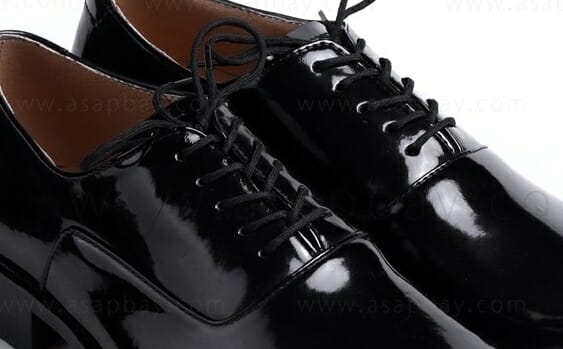A long time ago, I came across a reference to the fact that few men know how to properly lace dress shoes but I just rolled my eyes figuring “how big a difference does it really make“? Well, when it comes to formal shoes and flat silk laces, quite a bit of difference actually.
In my defense, the improper crossover method I’ve been using all these years is actually more practical because it makes the laces easier to tighten and adjust. However, the busy, asymmetrical look of the lacing conflicts with the simple elegance of proper dress shoes. That disharmony is compounded when the shoes are formal patent and the laces are flat silk which stand out due to their sheen and width. (For more on these classic laces, check out this previous post.)


Fortunately, the straight lacing method is just as easy as the less sophisticated method. Here’s how you do it, courtesy of Valet magazine:

It’s one of those little sartorial touches you regard as inconsequential until you actually try it and find yourself shuddering at the thought of doing it any other way. Like showing shirt cuff with a suit jacket or a large tie knot with a wide collar opening. In fact, you’re likely already obsessing about it after just reading about it in this post.
You’re welcome.
________________________________________

Postscript
November 3, 2014
Reader Hans Servando has provided a cleaner method of straight lacing that avoids any type of lace crossing. In the method above, the most visible part of the lacing – that atop the throat – is straight but the lacing underneath the throat is crossed. Shoes with a more open throat, therefore, can benefit from the following method found on Ian’s Shoelace Site, a website devoted entirely to methods of lacing shoes (animated, no less). Note, though, that this technique will only work for shoes with an even number of eyelets.


That’s the way I do it, European Straight as it’s called on Ian’s Shoelace Site. I use it on all my shoes short of casual shoes, whether or not they are balmoral.
I like to get the straight look in a different way. Just spiral one side of the lace through all the holes. The other side goes directly from the bottom to the top hole.
– easier to lace
– easier to loosen because you can at once create slack from the top and the bottom side
– no one sees the difference with this technique
I’ve noticed that technique is often used in shoe stores.
This is also the technique used in the military for shoes and parade boots.
I learned the “straight” lace more than a half century ago in, of all places, Maple Leaf Gardens in Toronto. We were taught to use the straight lace because it was easier to apply different pressure points on the skate. It looked so good that I have been doing the same since then on all my shoes. Any other way of lacing up appears just …shoddy.
Cleverly also sell the formal laces, in two different widths. I bought a pair to make my off-the-rack patents look a bit more elegant. They do–especially with the straight lacing.
Straight lacing is much easier and does look a lot neater, but I am so used to wearing Ghillie Brogues now that I’m using crossed laces for everything, because straight laces doesn’t look right with proper brogues.
Thanks! Well explained with perfect images. I saw this video on how to lace formal oxfords , Hope you enjoy this too –
Thanks. I’ve been using only the method noted in the Postscript because I wear wide shoes which all have an open throat design and that design exposes the diagonal lacing used in the original example.